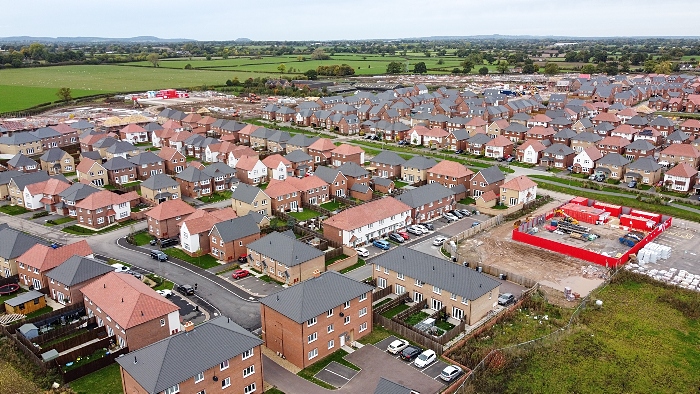
With economic growth in Cheshire increasing significantly in the last few years, supply and demand for housing has become unbalanced.
While 76.87% of the required housing was built in 2022, Cheshire is becoming one of the fastest-growing economies and could further reduce the amount of available housing.
Could 1st-time property developers solve the problem?
Cheshire’s property market has grown notably, attracting developers and investors alike.
With house prices increasing by 12.8% over the past year and rental values soaring by 85.6%, it presents lucrative opportunities for those seeking high returns.
This offers a promising opportunity for aspiring property developers to enter the property market.
In 2015, it was announced that Cheshire East Council needed 36,000 new homes by 2030, while Cheshire West had the target of 22,000 new homes between 2010-2030.
In Cheshire West & Chester, a total of 17,848 have already been completed since 2010, so a further 4,152 properties are needed in the next seven years, a manageable number.
On the other hand, Cheshire East has completed 71,110 dwellings, already far exceeding the number needed by 2030.
While both are further ahead of many other regions when it comes to new builds, the population in the area is still growing, with Cheshire West & Chester increasing by 8.4% since 2011, and Cheshire East growing to 7.7% in the same period.
To compare, London has also grown in population by 7.7% since 2011, demonstrating the potential need for more properties to be added to the market.
Building new houses may not be the only answer to the rising population and possible undersupply.
An estimated 1 in 71 houses in the area are empty with 1,552 properties having been empty for more than six months.
In Cheshire West & Chester, the Empty House Strategy is aiming to put more empty houses back on the market, but new developers could take a slice of this opportunity.
When it comes to property prices, Cheshire has experienced a surge in the last year with the average house prices in Cheshire East rose by £25,179 – a 9.31% increase.
Cheshire West and Chester saw a slightly higher increase with 13.27% increase on average house prices, resulting in a healthy £31,956 boost in price.
While the buyers market increases in value, so does the rental market.
The cost of rent has risen on average by 20.5% over the last three years across the North West, with Cheshire alone seeing an annual increase of 7.8%.
The increase in rents across the UK, have sparked a surge in the number of build-to-rent (BTR) developments taking place.
The BTR sector is poised for remarkable growth, as the number of completed homes is projected to surge five-fold by 2032, reaching an impressive 380,000 units.
This expansion is anticipated to elevate the sector’s value to an astounding £170 billion.
In Cheshire alone, we have seen development companies already taking the opportunity to make a profit in a growing sector.
In October 2022, Peel L&P launched a dedicated BTR company, Letta, which is to provide energy efficient, single-family Build to Rent homes in the North West.
Their first development in Cheshire is located at Ellesmere Port, which consists of 218 apartments with an EPC B rating, a mix of two, three, and four-bedroom residences.
The properties will have high ceilings, large windows, and open-plan interiors, as well as insulation and triple-glazed windows to avoid heat loss; smart technology that recovers heat from wastewater and controls lighting and heating; and electric vehicle charging ports.
Homes are surrounded by huge neighbourhood green spaces and gorgeous landscaping.
New builds can sometimes be more favourable for experienced developers. However, new property developers can still reap the rewards when starting out by ‘property flipping’.
Property flipping is a type of investment that involves purchasing a property with the intention of renovating and reselling it for a profit.
It is a strategy commonly employed by novice property developers as it offers the potential for significant returns without the complexities and costs associated with new builds.
By identifying undervalued properties in desirable locations and making strategic renovations and cosmetic enhancements, property flippers can add value and attract potential buyers or renters.
This approach allows new developers to enter the market, gain valuable experience, and generate profits while contributing to the revitalization of the housing market.
According to a recent survey conducted by Finbri, a UK bridging and development finance company, it was found that 45% of property investors showed a keen interest in investing in the property market in 2023.
The North East region saw a relatively low proportion of ‘property flips’, with only 12.09% of such projects taking place there whereas the Midlands accounted for 17.48% and London for 25.27%.
These statistics shed light on the divergent patterns observed in property refurbishment across various regions and emphasise the potential opportunities that exist in these areas.
Experienced and new investors alike have the opportunity to engage in property flipping, a successful strategy for reintroducing housing inventory into the market.
What are the benefits of property investment?
Investing in property development presents two key advantages.
Firstly, there is the potential for capital appreciation, where the value of your property assets can increase over time, leading to significant financial gains.
Engaging in a property development strategy that involves purchasing properties for renovation or refurbishment and then selling them for a profit, commonly known as property flipping, can yield rapid returns.
According to a survey conducted by Bridging Market in 2022, 50% of property flips resulted in gains ranging from £10K to £50K, with only a mere 1% experiencing losses.
The second benefit is income generation. Opting to retain ownership of your properties and leasing them to tenants can provide a steady source of income.
A recent study by Finbri indicates that rental rates are on the rise across the United Kingdom, with certain areas experiencing a growth of 14.6% in the year leading up to September 2022.
This upward trend is particularly evident outside of London, notably in Northern Ireland.
These findings suggest a promising potential for rental income and a robust market beyond the city centre.
Investing in property offers the opportunity for both capital appreciation and income generation, making it an appealing option for investors seeking to build wealth and secure a reliable source of revenue.
What are the initial steps to begin your initial property development project?
Ensuring a healthy profit margin on your first assignment requires simplicity.
Undertaking a basic property development venture offers several benefits:
● Lowered Risk: It poses a lower risk compared to intricate projects.
● There is still a chance to generate a decent profit.
● The learning curve is quite manageable, making it easier for beginners to learn.
● Easy Financing: Smaller projects are more likely to be approved for financing.
● Enhanced Prospects: This industry presents more extensive possibilities.
● You can save money by using your trade skills and independently performing some tasks.
Acquiring a property for renovation, to sell or rent it out, is among the simplest forms of real estate development.
Novice investors are occasionally attracted to real estate requiring prompt repairs and aesthetic upgrades.
Starting with residential homes is an excellent option for those new to property development.
Their approach leverages your knowledge of buying and renovating homes without needing expertise in commercial, storage, office, or student housing sectors.
Aiming for a profit margin of 20% or more when engaging in a fix-and-flip venture is advisable.
Be ready to leave if the profit margin is insufficient. Your initial profit is determined by the price you pay for the purchase, as you have control over it. The market determines the sale price.
Professionals recommend that individuals who aspire to become developers should follow these steps:
In property development, every asset has a maximum price in an open market transaction, known as its “ceiling value.”
Consider Exploring Up-and-Coming Areas: Rather than purchasing the least attractive property on a well-established street, consider researching the next promising emerging neighbourhood or street.
Enhancing Property Value: Real estate professionals suggest that incorporating open-plan living areas can increase the value of a property more significantly than simply adding extra rooms.
Plan for the Unexpected: Define your core strategy, whether it involves selling or renting out the investment property, and explore alternative options as contingency plans in case your primary strategy does not yield the desired outcomes.
Exploring Rental Options for Your Investment Property
When considering rental options for your investment property, there are various approaches to explore.
Unless significant structural renovations are needed, a buy-to-let mortgage is a popular financing option for purchasing a property if you don’t plan to keep it.
The expected rental income and the property’s location play a significant role when making development decisions.
It is crucial to evaluate whether the property has enough bedrooms to accommodate families, young professionals, or students.
Option 1: Leasing to an Individual Tenant, Pair, or Household.
Many new investors prefer a single lease agreement with one tenant, a couple, or a family.
This method ensures that the monthly rental income will be sufficient to cover your buy-to-let mortgage payments and any other administrative and maintenance expenses, leading to a profitable outcome.
Minimising management costs can be achieved by managing a property with a single tenant, and this also increases the chances of the tenant staying for a longer duration, which in turn provides stability for your property.
It is essential to consider the possible risk of vacancy periods since they can substantially affect your yearly profits if the property stays unoccupied and generates no revenue.
Option 2: House in Multiple Occupation (HMO)
You may consider converting the property into a House of Multiple Occupation (HMO) as another option instead of renting it to a single tenant.
The idea is to offer all tenants communal kitchen, living and bathroom facilities while renting out individual rooms within the property.
By negotiating leases on an individual basis, it may be possible to boost the amount of monthly rental income significantly.
Managing an HMO could result in increased costs for upkeep and administration.
Managing bigger HMOs with five or more occupants can result in higher profits but also involves more administrative duties.
Coordinating essential upgrades and repairs in such situations can be more challenging. Moreover, you can still earn rental income even if your HMO or Large HMO is partially occupied.
It is essential to conduct comprehensive research and comprehend the planning and construction prerequisites for HMOs established by the local authorities before commencing any HMO project.
Getting acquainted with these regulations can assist you in navigating the process with greater efficiency.
Option 3: Selling the Property After Renovation
Another feasible choice is to sell the property once it has been renovated.
It is essential to consider the possible consequences of obtaining a mortgage for an extended period if you intend to sell the property.
It is crucial to comprehend the potential impact of early repayment fees (ERFs) before deciding to pay off your mortgage early, as they can significantly affect your overall profit.
If you need funding for a project immediately, consider looking into short-term capital options like bridge financing or bridging loans.
These loans provide Repayment flexibility, enabling you to repay the loan once your projects are finished.
The Essential Phases for Property Development Success
To excel as a property developer, it’s essential to become proficient in three key stages: sourcing, feasibility, and planning; financing and exit strategy; and construction, scheduling, and project management.
Stage 1: Sourcing, Viability, and Preparation
In the sourcing stage, locating a property at the most favourable price and evaluating its potential with a discerning perspective is crucial.
Conducting thorough market research is critical to comprehending the maximum house prices, rental rates, and upcoming areas in the locality.
Rather than choosing the least desirable property on a desirable street, you may want to consider a less expensive house nearby that would attract potential buyers or renters.
Phase 2: Financing and Exit Strategy
To undertake a property development project, obtaining funding and creating a plan for exiting the project is essential.
It is advisable to seek the assistance of a proficient finance broker, as conventional banks may not offer the desired rates and flexibility.
One can consider different funding choices, like buy-to-let mortgages, bridging finance, development finance, or second charges.
Knowing the lending criteria and costs can prevent future issues.
A well-defined plan for exiting is essential to recoup your investment and achieve profitability by selling or keeping the property as a rental asset.
Phase 3: Construction, Scheduling, and Project Management
During the construction phase, it is crucial to have efficient management and strict adherence to the schedule.
Planning carefully and managing projects diligently is essential to avoid escalating financing costs due to delays.
You can hire a principal contractor, engage a project manager, or self-manage depending on the scale and expertise of the project.
Thoroughly evaluate the trades required, any potential scheduling issues, and the option of gaining extra skills to handle expenses efficiently.
Planning and assessing every aspect of your development project is crucial.
Evaluate the trades required, possible scheduling overlaps, and chances to enhance your skills to decrease dependence on outside contractors.
Create a detailed schedule for each phase to estimate how long it will take.
Incorporating these considerations and developing a comprehensive strategy can help you navigate the property development process effectively.
By addressing housing demands, you can also maximise your investment opportunities.
Prepare yourself for a fulfilling experience in the field of property development.


















Recent Comments